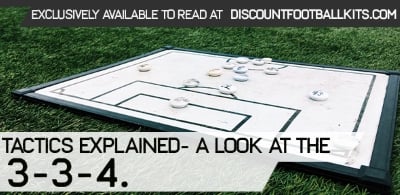In the continuation of our series exploring football formations, today we take a look at the rather unusual 3-3-4 system.
Although this tactic is scarcely used in modern football (other than when chasing a late goal at the end of a game), it has had some recent exponents and remains a viable choice for high-pressing and attack oriented sides.
But what is this system, and where did it originate? We’ll explore this in the post below!
What is the 3-3-4 and its Origins?
An undeniably aggressive and attacking system, the 3-3-4 comprises three central defenders, with this defensive line protected by three industrious and hard-working midfielders.
As for the forward line, this will usually incorporate two traditional and touchline hugging wingers, whose main role is to provide genuine width and a creative supply line to two central strikers.
Clearly, there’s a strong attacking overload here, and the formation first evolved during the mid-1920s.
At this time, many sides deployed a basic 2-3-5 formation, but a change in the offside rule in 1925 (which rules that a player was considered offside unless two or more opposing players were in front of him following the release of the ball) encouraged teams to rebalance their shapes and look to adopt an offside trap.
This was suggested by Arsenal player Charlie Buchan to manager Herbert Chapman, with the team switching to a 3-3-4 that incorporated an additional defender and removed one of the three central forwards.
Of course, the emergence of the flat back four in the 1950s (and the trend for defensive football that dominated Italian football through the 60s) forced a large-scale abandonment of the 3-3-4.
However, it has been revived occasionally, with Porto largely deploying this shape during their successful 2005/06 season. Certainly, the side deployed three centre backs and three central midfielders, including Isbon and the attack-minded Lucho Gonzalez.
While some argued that Porto’s system was more akin to an attacking 3-5-2, the manager Co Adriaanse deployed attacking wide players such as Ricardo Quaresma in his lineup. This created a de facto 3-3-4 when Porto were in possession, creating a standout system in European football.
What are the Player Roles in the 3-3-4?
The three defensive players in the 3-3-4 system often operate in the way of a standard back three. However, this formation can feature the central player as a sweeper or ‘libero’, while the left and right centre backs may be required to operate a little wider in some instances.
As for the midfield three, this will almost include a deep-lying ball winner or playmaker, who’s tasked with both breaking defensive lines with the ball and screening the defence when the side is out of possession.
Either side of this player will usually sit two dynamic box-to-box midfielders, who will supplement attacks and look to make runs beyond the forward line when their team is in possession.
However, they must showcase discipline and a strong work-ethic when out of possession, with a particular focus on covering wide areas and negating the natural lack of defensive width in the shape.
Occasionally, the midfield three will include an attacking playmaker, but this can disrupt the delicate defensive balance in the side and leave sides exposed when in transition.
As for the forwards, the two wide players will typically operate high and provide natural width on the right and left. This will mean that the wingers should play on their natural sides, as they look to provide quality service from wide areas and create chances for forward runners.
They can also supplement the attack when the ball is on the other side of the pitch, as they look to provide a direct goal threat and occupy their opposing fullback.
When out of possession, the wide players will also be required to track their respective fullback and drop a little deeper. This can turn the system into a 5-3-2 or 3-5-2 when the side is out of possession, creating a more orthodox shape and better defensive structure across the pitch.
But what about the central attackers? Well, these two players may operate as twin strikers, who press high against their respective centre-halves and provide a target for crosses and balls in behind.
However, there’s also the potential for one of the two central strikers to drop deeper and create an overload in midfield, while simultaneously drawing opposition defenders out of position and making it possible to play more fluently between the lines.
The Last Word
Ultimately, the 3-3-4 is an unusual shape, and one that’s rarely used as a consistent or starting formation in 2022.
However, it retains genuine merit as an effective attacking and high-pressing formation, and one that arguably makes it easier for sides to go man-for-man with the opponents when pressing high against a traditional back four.
It’s also interesting to note that many sides operate this shape having transitioned into possession, including Thomas Tuchel’s Chelsea (at times), Liverpool and Bayern Munich.
Defensively, a 3-3-4 also becomes a 3-5-2 and 5-3-2 formation, with the wide players crucial to the functionality of the system at both ends of the pitch.










